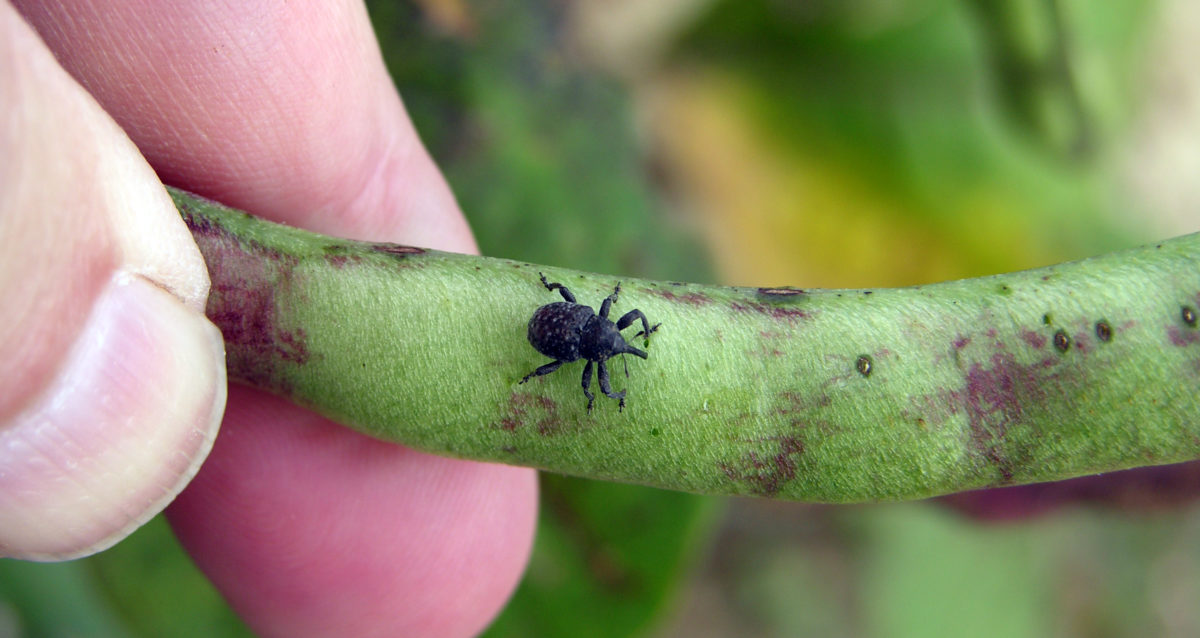According to UF/IFAS, Asian bean thrips (ABT) populations continue to swing back and forth across the South Florida region. While flower thrips are the predominant species north of Miami-Dade, a few locations still are reporting ABT at the dominant species. ABT populations ranged from 0.2 to 0.7 per bloom in southeastern Hendry County. Populations were reduced where records of 10 …
Managing Cowpea Curculio
Another southern pea season means one thing for Alabama producers; cowpea curculio will be a factor. “If you’re a southern pea grower, odds are you have seen this insect or will see this insect at some point in the production cycle,” said Neil Kelly, Alabama Extension Regional agent in Southeast Alabama. “Over the last several years, it has become devastating …
ABT Infestations Continue in South Florida
South Florida bean producers continue to contend with Asian bean thrips (ABT) populations. According to the University of Florida/IFAS, populations vary from farm to farm and planting to planting. In southeastern Hendry County, populations averaged 0.1 ABT per bud and 0.2 to 0.5 ABT per bloom. Even the older plantings had reached counts totaling 2.2 ABT per bloom. Because of …
Mite Management on Southern Highbush Blueberries
By Oscar E. Liburd, Lorena Lopez and Doug Phillips Mites can cause significant damage on blueberry plants if not properly managed. Mite species that feed on southern highbush blueberries (SHB) include the southern red mite (Oligonychus ilicis) and the false spider mite or flat mite (Brevipalpus yothersi). The southern red mite is the primary mite pest feeding on blueberry plants …
Pecan Producers Be Wary of Phylloxera
There’s beginning to be budbreak in pecan orchards throughout the Southeast. As trees start to break dormancy, producers need to begin protecting their crop from one pest who impacts trees this time of year, says Lenny Wells, University of Georgia Cooperative Extension pecan specialist. “We’re just starting to see it now. This is the time they need to (spray), if …
Warmer Temps Mean Increased Pest Pressure in South Florida
Temperatures are starting to warm considerably in South Florida. Vegetable farmers need to be mindful of various insects that thrive in hot conditions. “It’s been warming up so you kind of expect to see a flush of pests in the near future. It’s kind of hit and miss in some places with whiteflies and things,” said Craig Frey, University of …
Effectively Managing Pests While Protecting Pollinators
By Sylvia Willis, Amy Vu and Jamie Ellis Pollinators play an important role in the production of crops around the nation. Different crops rely on different techniques for pollination. Corn, for example, uses wind to carry pollen to female flowers, whereas watermelon depends on pollinators to deliver pollen. Pollinators include insects, birds and bats. Many fruits and vegetables result directly …
Ant Control: Alabama Extension Encourages Farmers to Protect Crop
Vegetable crops are vulnerable to ant pressure this time of year. Alabama Extension encourages vegetable producers to implement management tactics as they begin planting this year’s crops. According to Alabama Extension, fire ants can protect aphids and other honeydew producers on vegetables, which makes their effects worse on the plants. Fire ants can also interfere with natural enemies. Ultimately, though, …
Protecting Your Investment: Trap Cropping a Unique Insect Management Strategy
Trap cropping is an insect management strategy that saves farmers time and money and protects the ecosystem, specifically beneficial insects, from overuse of pesticides. For example, using sorghum in a field alongside tomatoes protects the tomato crop from leaf-footed bugs. It’s a unique tactic of sacrificing one crop for the safety and protection of the money-making crop, says Ayanava Majumdar, …
Mighty Mites: UGA Extension Encourages Scouting for Strawberry pests
It won’t be long before strawberries will be ready for harvest in South Georgia. University of Georgia Extension encourages producers to scout for spider mites, especially as strawberries begin to ripen and bloom across the state. The two-spotted spider mites are typically light yellow in appearance with a spot on either side of their abdomen. Their piercing-sucking mouthparts can cause …










